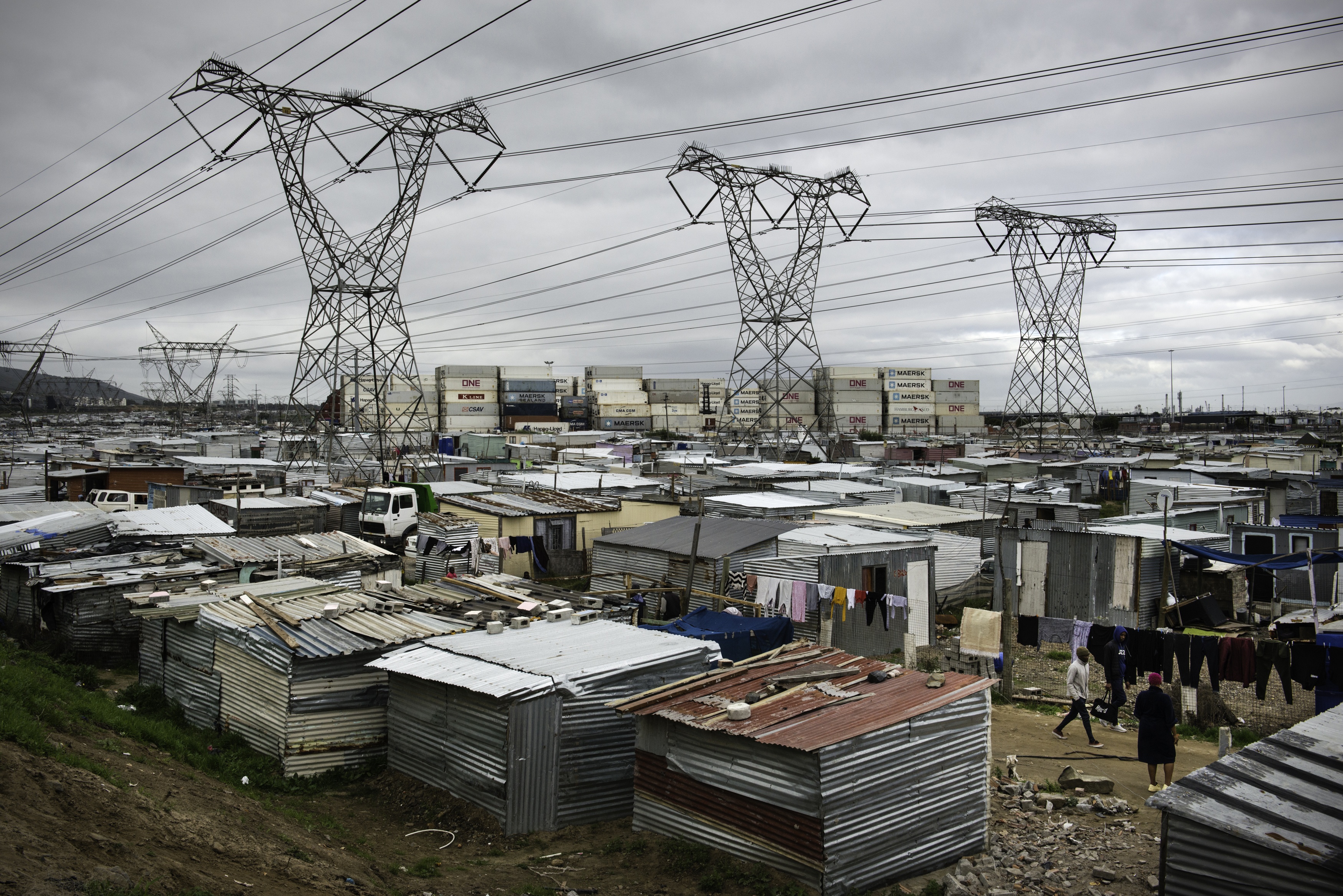Image: Bram Lammers / Dunoon informal settlement, Cape Town
By Tracy Ledger
In many households, a choice must be made each month between electricity or food. No matter which option the household chooses, the impact is negative, not just for that household, but for our collective ability to make meaningful progress in economic and social development.
[First published in Daily Maverick]
It is generally understood that access to (reliable) electricity for mining, business and industry is a critical input for economic development. It is the main reason why government has put addressing electricity supply constraints as the number one goal of Operation Vulindlela — the plan to implement a number of priority structural reforms designed to reinvigorate the economy.
Less well recognised is the central role of access to electricity for poor households and small enterprises in supporting development. Universal access to electricity is positively correlated with a wide range of socioeconomic benefits:
- Households that have access to electricity are much more likely to start a small business enterprise than those that do not;
- Access to electricity allows existing small businesses to engage in a range of additional value-adding activities, increasing household income and expenditure;
- Small agricultural enterprises (the most important potential source of employment and income for households in rural areas) require electricity to increase productivity;
- Access to electricity supports improved household food security: households can store and cook food more efficiently, reducing its cost, when they have access to electricity;
- Electricity is positively associated with better educational outcomes, supporting study at night and access to the internet;
- The ability to use electricity for cooking reduces indoor air pollution, which currently kills more than 1,000 children under the age of five each year in South Africa; and
- Each year, thousands of deaths and injuries result from fires caused by paraffin or candles.
In summary, universal access to electricity contributes directly — and significantly — to a wide range of South Africa’s most important development goals. Access to electricity is essential to leveraging and increasing the impact of existing state expenditure across a wide range of areas, from small enterprise development to household food security. Conversely, lack of access undermines these goals and makes them more difficult to achieve.
In this developmental role, electricity is analogous to education: it is generally understood that universal access to quality education is critical to supporting broad-based development. Although it is the individual who benefits directly from that education, there are many more benefits for the whole of society. This is the reason why the cost of education is subsidised by the state in so many countries; we all benefit in the long term from that investment.
Making sure that every household and every small enterprise has access to electricity should, therefore, be a national priority.
In theory, it is a priority, and a long list of policy documents since the 1998 White Paper on Energy have all emphasised the importance of universal access to electricity. By its own measurements, the state believes it is doing a very good job of reaching this goal.
It isn’t. And as a result, we are losing out on a critical development pathway.
The Public Affairs Research Institute’s (Pari) new publication Hungry For Electricity traces the reasons for this. The main problem is the inadequate way in which “access” is defined. That definition determines both how progress is measured, as well as the strategies needed to achieve the goal of universal access.
In this country (and in many others) access to electricity is generally defined as electrification — the physical connection of users to the grid. This definition means that we measure progress in terms of the number of households that are connected, and strategies to increase access thus focus on funding the national electrification programme.
While physical infrastructure is obviously necessary for access, it certainly isn’t sufficient. A connection is just the first step: in order for electricity to actually deliver on its development potential, households and enterprises must be able to access a certain minimum amount on a regular basis.
We have described this minimum amount as the “minimum threshold level of consumption” (MTLC). The MTLC is the amount of electricity consumption at which development benefits begin to accrue: the level of usage which facilitates higher levels of economic activity and productivity, that supports improved food security, health and education outcomes.
The MTLC is a key concept: it implies that electricity will only deliver its development potential above a certain level of consumption, and not just because the delivery infrastructure is in place. If households and small enterprises use smaller amounts of electricity (i.e. below the MTLC) there will be some marginal benefit, but the substantial development kickstart that could be achieved in return for the significant investment in electrification will not materialise.
We could describe the kind of electricity access that drives substantial improvements in development as “enabling access” and differentiate it clearly from physical access (which is correctly just one component of enabling access). The goal should be enabling access, but we focus almost all our efforts on delivering physical access.
Measuring how many households are connected to the electricity grid doesn’t tell us very much about whether or not that electricity is actually facilitating development. And the evidence is overwhelming that while we may be delivering physical access, we certainly are not delivering enabling access, evidenced by South Africa’s high levels of household energy poverty.
It is estimated that around 50% of households are energy poor, despite a household electrification rate of 86%. It is critical for our development goals that we understand the reasons for this gap, and take steps to rectify the situation.
The main barrier to enabling access (and far more important than reliability of supply) is the ability of households to pay for the MTLC. All households that are connected to the grid use (and pay for) some electricity, but in the majority of poor households (that is, the very households that need electricity to move out of poverty) cost presents an insurmountable barrier to accessing the full MTLC.
In many households, a choice must be made each month whether to spend money on electricity or on food. No matter which option the household chooses, the impact is negative, not just for that household, but for our collective ability to make meaningful progress in economic and social development.
In this way, a vicious cycle of energy poverty and poverty is entrenched: households are too poor to afford the energy that they need to move out of poverty. Although South Africa has a subsidy policy in place (the Free Basic Electricity policy, FBE) the amount that is made available under the policy (50kWh per household per month) is much too low to break that poverty cycle. In addition, the policy has been a dismal failure in implementation.
The only way to deliver the significant development potential of universal access to electricity is to greatly expand the amount of FBE allocated to each household, and to ensure that every one of the approximately 9.5 million households living in poverty who have a physical connection to the grid receives it.
Of course, there is a fiscal implication — the increased allocation must be funded out of the national budget. We are all aware of the current fiscally constrained environment, but there is a strong argument to be made that this additional expenditure is one of the best choices we could make:
- Increased access to electricity is one of the most effective policies to achieve (in a relatively short period of time) significant socioeconomic development impact across a wide range of priority areas. We need to see budget allocations in this regard as strategic investments, and not as “charity”;
- In contrast with many other budgetary disbursements, all of the funding for FBE goes back into the state: the majority of qualifying poor households are customers of Eskom, which means that it will be the main recipient of these funds. The state already makes a significant fiscal contribution to Eskom: we would greatly increase the development leverage of that funding if it simultaneously expanded access to electricity; and
- Increasing the household allocation of FBE will remove much of the incentive for illegal connections and electricity theft where a formal connection is possible. There are significant costs associated with this theft, which will be reduced.
The question is not whether we can afford to spend more money on achieving universal enabling access to electricity. The real question is whether we can afford not to.


